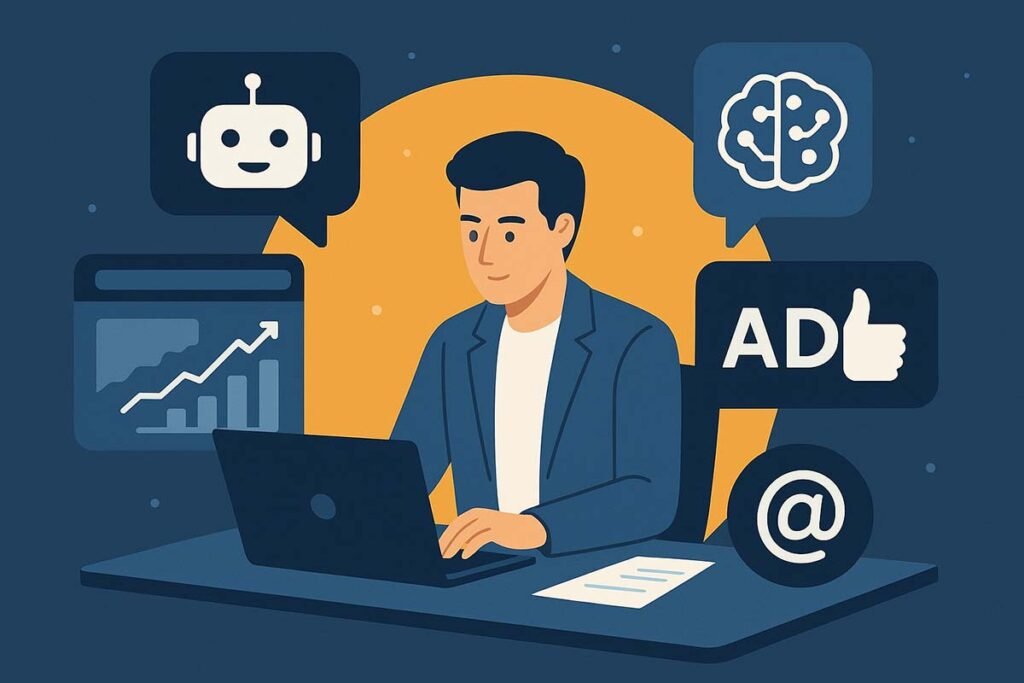Marketing in 2025 isn’t just about creativity — it’s about data-driven intelligence powered by Artificial Intelligence (AI). From personalizing ads to generating content, AI has transformed how businesses reach and convert customers. The marketers who adapt now are setting themselves up for higher ROI, lower costs, and faster growth.
In this article, we’ll explore key trends in AI marketing for 2025 with real-world examples (many you’re probably seeing in action right now) and how you can apply them to your own business.
1. Hyper-Personalized Customer Experiences
Trend: AI analyses user behaviour — browsing history, purchase patterns, demographics — to create tailor-made customer journeys.
Example: Netflix personalizing movie recommendations; Amazon showing “Frequently Bought Together” items that match your latest searches.
How Businesses Can Use It:
- AI email marketing tools like Klaviyo to segment your audience.
- Dynamic website personalization using Optimizely or Adobe Target.
2. Predictive Analytics for Smarter Campaigns
Trend: AI predicts which customers are most likely to buy, when, and via which channel — cutting ad waste.
Example: E-commerce stores predicting when a customer is about to reorder a product and sending them a targeted discount email.
How Businesses Can Use It:
- Use HubSpot or Salesforce Einstein for lead scoring.
- Analyse social trends to time your campaigns.
3. AI-Powered Content Creation
Trend: Tools like Jasper, Writesonic, and ChatGPT produce blog posts, ad copy, product descriptions, and even video scripts in minutes.
Example: A small Shopify store creating 20 product descriptions in a day using AI, saving weeks of manual work.
How Businesses Can Use It:
- Combine AI writing with human editing for best results.
- Batch-create seasonal ad copy for multiple platforms.
4. Voice Search Optimization
Trend: With smart speakers and voice assistants booming, AI is changing SEO for natural language queries.
Example: Instead of typing “best pizza near me”, users say “Hey Google, what’s the best pizza place open right now?”
How to Adapt:
- Use conversational keywords in your content.
- Optimize local SEO with Google Business Profile updates.
5. AI in Social Media Listening & Engagement
Trend: AI tracks brand mentions, competitor activity, and trending topics in real time.
Example: Brandwatch alerts companies when their name is trending online — positive or negative — so they can respond instantly.
How to Use It:
- Monitor engagement sentiment.
- Discover untapped niche communities.
6. Chatbots & Conversational Marketing
Trend: AI chatbots handle FAQs, product recommendations, and even sales — 24/7.
Example: Sephora’s chatbot suggesting personalized makeup products based on answers to quick questions.
Benefits:
- Lower response times.
- Increased lead conversion rates.
7. Automated Ad Targeting
Trend: AI ad platforms like Google Performance Max and Meta Advantage+ now handle targeting, bidding, and creative optimization automatically.
Example: An online tutor running one campaign that AI automatically serves to parents of school children most likely to sign up.
Pro Tip: Always monitor post-campaign reports to refine targeting ideas.
8. AI-Generated Visuals & Videos
Trend: Marketers create high-quality designs, animations, or video ads using AI — saving massive production costs.
Example: A local café generating AI-designed Instagram ads for weekend promotions in minutes using Canva AI.
How to Use:
- AI-powered design tools for speed.
- Customize visuals with brand colors for authenticity.
9. Real-Time Campaign Optimization
Trend: AI adjusts campaigns on the fly — reallocating budget to top-performing ads.
Example: Facebook’s AI shifting your ad spend to the best-performing demographic during the campaign instead of after it ends.
Pro Tip: Allow “learning periods” before making manual changes.
10. Sentiment Analysis for Brand Health
Trend: AI scans reviews, tweets, and posts to gauge how your audience feels about your products or campaigns.
Example: A hotel brand discovering low satisfaction for a particular location and fixing the issue before it escalates.
How to Use:
- Use tools like Talkwalker, Brand24, or Sprout Social for analysis.
How Small Businesses Can Get Started
- Pick one AI marketing tool and test it for 30 days.
- Automate at least one repetitive process — like email scheduling or social media posting.
- Slowly integrate AI personalization into your site or campaigns.
AI is rewriting the rules of marketing in 2025. Whether you’re a solo entrepreneur or part of a large marketing team, using AI tools strategically will save time, cut costs, and help you build deeper relationships with your audience.
💡 Action Step: Choose two trends from this article and apply them to your next campaign — track the difference AI makes.




Pingback: Cybersecurity Essentials for Americans: Using AI to Protect Your Digital Life in 2025 - FirstsPost
Pingback: Best AI Communities & Forums to Learn and Grow (2025) - FirstsPost